
It allows to keep PV going, with more focus towards AI, but keeping be one of the few truly independent places.
-
Anyone comment on this gimbal vs the beholder ds1 for use with the GH4 and the 12-35 lens?
-
Does anyone know if i can invert the crane and use it for low angle shots? Popular in action and horror movies :-)
-
You can.
-
Hi All
Bought the Zhiyun Crane Z1 from PV with the Bluetooth remote. Arrived on Saturday and after playing around with it for a few hours I took it out to a shoot. Working really well so far, gimbal, app and remote. Instructions were all in chinese but there's enough setup videos to see how to get the hang of balancing it. Using the G7 and Olympus 12-40mm f2.8 . After a couple of practices set up is really quick. Once balanced for te camera on all axis, the only balance you need to change when dramatically changing focal length is the camera's position on the screw thread to stop it flopping. Quick and easy to do between shots with negligible downtime.
I will report more when I've had more use with it.
-
Since the handle detaches is there a dual handle attachment like the pilotfly h2?
Thinking about selling my DS1 to get this.
-
-
Do you have prices and pics yet?
-
Their own look like
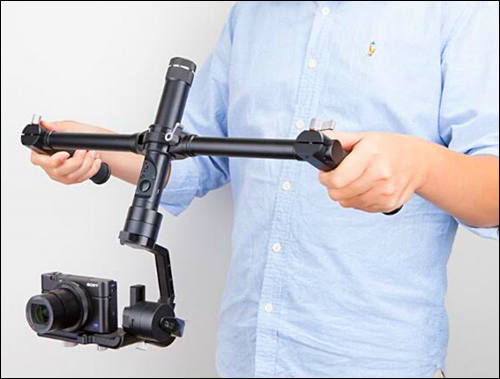
I let you know prices later.

 img2917.jpg500 x 379 - 27K
img2917.jpg500 x 379 - 27K -
So, Zhiyun own handles are $95 (including shipping), cheaper with gimbal, see first page at
http://www.personal-view.com/talks/discussion/15338/zhiyun-z1-crane/p1
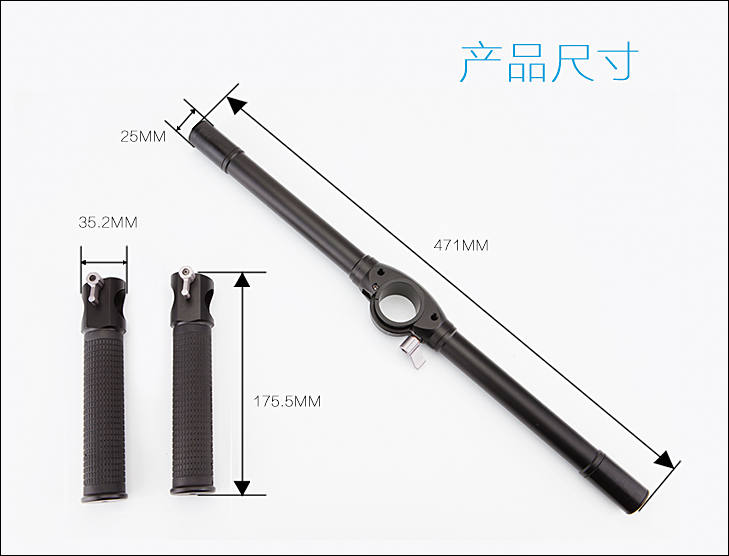
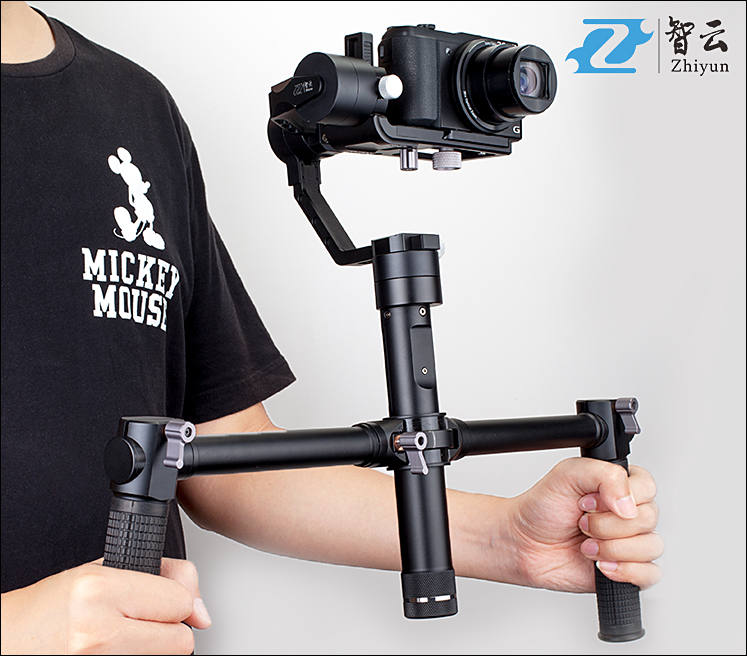

 img2935.jpg729 x 556 - 37K
img2935.jpg729 x 556 - 37K
 img2934.jpg747 x 656 - 66K
img2934.jpg747 x 656 - 66K -
Ugh this wasn't what I was hoping for. I was hoping something comparable to the Pilotfly H2 or Came Optimus dual handles.
-
I was hoping something comparable to the Pilotfly H2 or Came Optimus dual handles.
This approach is actually best of that I know of, as allows to adjust gimbal position. And camera itself is better positioned.
-
Recent firmware for larger weights
Our crane can hold max weight 1800g now
-
Face tracking also comes to gimbal
-
How to update to have this " face following " . I tried but keep getting " Network error " with app. I think it is going okay with old classic way by computer, trying now
-
I follow that above you tube video successfully with firmware 1.5. The App show latest firmware should be 1.51 but i could not update by this way
-
I've got a problem with updating from a Mac by USB cable, running Yosemite 10.10.5 . I have their USB driver installed, but I don't get a connection to the Crane even if i follow the instructional video closely. The gimbal just doesn't show up.
Any idea?
-
Bought one of these via Personal-View a couple weeks ago, been having a lot of fun with it!
Using a GH4 and 7-14 f.4, I've taken it on a couple of jobs where we had plenty of time for B Roll and achieved some really nice shots.
Are there any tutorial videos available that show the uses for the different operation modes (Roll, Yaw, Pitch)? Would like to expand my knowledge of shot possibilities, haven't found many specific videos outside of reviews and tests so far - great piece of kit, highly recommended, will post some videos that feature Crane shots once they're signed off by clients.
-
Handles
-
When trying to update the crane. I keep getting a "Communication error check the connection " message . on a Mac OSX 10.10.5 yosemite. ignoring it solved the problem. Best year to all
-
Having done an article for "Digital Production" in German, I decided to translate it for you. Here we go:
The Zhiyun Crane Z1 – How Good is a Chinese Gimbal Now?
It has been a year and a half that I tested a Pilotfly H1 and you needed a lot of time to make it ‚fly‘ decently stable. Not only mechanical balance with the help of a hexagon key was fiddly and needed high precision. You’d have to adapt control parameters too after any change of weight and that needed even more patience until it became stable. Even then the gimbal would start to vibrate erratically if you needed a steeper vertical angle or only bumped into something. To get a gimbal for day-to-day use in a professional environment you needed considerably more money to buy products from Freefly or DJI. But now there is the Zhiyun Crane for a test flight …
My main criteria are all those connected with ease of use in a serious production, not something for people who are into fiddling with new technologies. Apart from the weight limit – which is not as simple to judge as you may think – there are lots of smaller, but important points:
- Fast balancing without tools (which are easily mislaid or forgotten)
- Acceptable weight for one-hand operation or an optional double handle
- Enough range for adjustment with heavy or long lenses
- Unlimited motion in all three axes
- Long lasting batteries
- Exchangeable batteries, preferably standardized ones
- Tolerance for small changes in balance like lenses extending while zooming or focusing
- Remote control
- Auto-calibration by reliable sensors
Many early models were quite the contrary: they needed balancing even after removing the lens cap or adding a thin cable for monitoring. Batteries were built in, you needed to calibrate on a flat surface and too many turns in one direction could squeeze and destroy small cables to the motors. But Chinese manufacturers are learning fast, as demonstrated by Zhiyun. The Z1 is a gimbal that ticks all of my boxes as listed above and costs 600,- $ if bought here at Personal View (plus national taxes). Mine arrived after just a few days in Germany. It comes in a sturdy case (Pelicase style, but not sealed) with everything you need except the camera and lens, even a support for longer lenses is included and a second set of batteries. Batteries are type 18650, a standard model. You can replace them by type 26650 for longer operation.
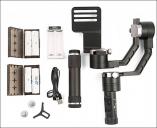
 Crane Ausstattung.jpg697 x 567 - 45K
Crane Ausstattung.jpg697 x 567 - 45K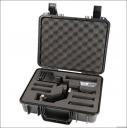
 Crane.jpg800 x 807 - 67K
Crane.jpg800 x 807 - 67K -
Capacity and Balancing
The gimbal weighs a tad under 1 kilogram without batteries. Once you have charged these with the included USB-charger you put them into the handle and screw the handle into the base. This takes quite few turns, but it is very important that nothing has play in a gimbal, so that’s fine with me. The construction looks and feels very well made. Regular weight limits are 350 to 1500 grams since firmware 1.5. But you can load an alternative firmware for cameras up to 1800 grams, aiming at users of DSLRs like a Canon 5D. For lighter cameras you’ll need to change firmware back to the general version, though. We had no problems balancing a Sony A7S with a heavy, but compact Minolta 21mm prime with a weight of 1260 grams.
But the weight of such a combination alone is not the only limiting factor: like for a dancer engaging into a pirouette or an astronaut in zero-G the distance of mass from the center is very important! A heavy and long lens, maybe even with an adapter, which is moving the weight far from the center can introduce too much rotational inertia. With such a setup the motors may have difficulties tracking your motions fast enough. Other than older gimbals the Crane will not go into erratic behavior, but you may feel a small push in the handle and that will introduce a small bump into the shot.
The space for adjustment is pretty good with the Crane and there are three slots in the base plate to choose from. Nevertheless there will always be some cameras and lenses where things get tight, like the heavier Sony A7R II. It can be balanced, but it’ll get so close to the tilt motor that the door for the SD card is blocked. Of course, this is the fault of Sony, not Zhiyun, since they changed their construction. The slot of the lighter A7S goes to the back and the door poses no problem. Or have a look at our BlackMagic Pocket camera with a beautiful Angenieux 20 to 80mm, which is blocked by the roll motor, so the tilt rotation will be limited. You’ll always encounter some combinations that stay well in the weight limits but don’t fit perfectly. Anyway that’s not the fault of this gimbal.
Balancing is really quick, with some practice you can stay well under 5 minutes and if you are only changing lenses with similar weight you’ll be even faster. Like with any gimbal you work from the inside first: roughly balance the camera on the plate, then adjust the balance for tilt by moving the L-bracket up or down. You may need to fine-tune the position on the plate after that. Next is balancing roll and finally horizontal pan. Always remember to fix the screws carefully or something may slip and you’ll need to start over. If you need to be really fast and your combination is not too close to the weight limit, you can even balance things a bit sloppy – the Crane can handle it!
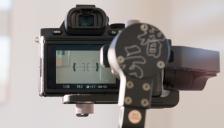
 Balance_klein.jpg800 x 458 - 207K
Balance_klein.jpg800 x 458 - 207K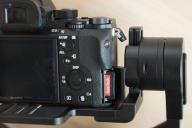
 A7R_II_nah_klein.jpg800 x 533 - 294K
A7R_II_nah_klein.jpg800 x 533 - 294K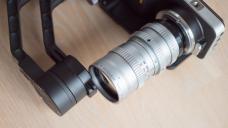
 Angie_klein.jpg800 x 450 - 306K
Angie_klein.jpg800 x 450 - 306K -
Activation and Stability
A longer press on the small, golden button until the light gets steady and your Crane will be activated. After two or three seconds the controller has booted and the camera literally jumps into position, i.e. it points horizontally to the front. In our case calibration was perfect from the start without any further adjustment, we could see no deviation from the „artificial horizon“ of our Sony A7.
Those who remember endless tuning of the first generation of SimpleBGC-controllers can breathe with relief. The Crane is not based on this standard platform (or it’s far better 32 bit successor) but a genuine development. According to Zhiyun there are three 32 bit MCUs working at 4 kHz – pretty impressive parameters. In our tests the Crane was quite insensitive to touching the camera or lens, it went straight back into position when left alone instead of going into erratic somersaults. If you want to reduce stress on the motors and save energy, you can send it into standby with a longer press on the joystick.
Removing a forgotten lens cover or adding a thin cable doesn’t impress the Crane very much, but nevertheless good balancing will reduce stress on the motors and power supply. Like any other gimbal the Crane will only compensate rotational movements, not any up or down motion – you’ll still need to learn how to walk for smooth shots. In the end you’ll be rewarded by very stable motion. The Crane stabilizes so well that you may use it instead of a tripod in a pinch, even with longer lenses which you can’t move smoothly by hand any more. Minor jitter of the hand could then be compensated in software.
We could never feel or see any jitter introduced by the Crane, only a high pitched sound became audible at close distance if it was balanced really badly – a proof of the high working frequency. If properly balanced there was no sound from the gimbal at all. Energy consumption depends on the amount of motion, but if you put the gimbal on a tripod and leave it on, it’ll run for about 6 hours with the standard batteries. Even with a lot of pans and running about it would run much longer than our Sony or BM Pocket camera.
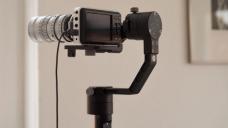
 Angie_BMPCC_Kabel_klein.jpg800 x 450 - 186K
Angie_BMPCC_Kabel_klein.jpg800 x 450 - 186K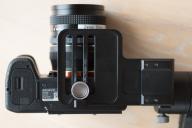
 Leichtes Objektiv_klein.jpg800 x 533 - 311K
Leichtes Objektiv_klein.jpg800 x 533 - 311K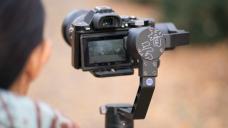
 Park_oben_klein.jpg800 x 450 - 251K
Park_oben_klein.jpg800 x 450 - 251K -
Controls
With wider lenses control by joystick works quite well. The first mode is „Pan Following“, where only horizontal movement is softly following your hand, while tilt and roll are fixed. Up or down pans can be initiated by the joystick. One short press on the joystick gets you into fixed mode, where all the axes are stable in relation to your hand, but the joystick now controls tilt and pan. Going into „briefcase“ mode needs no change at all, you just flip the handle over and the controller is sensing your intention. The camera stays stable and you can achieve very low positions in one fluid motion – impressive! A short double press of the joystick gets you into „Pan and Tilt Following“, so the camera will softly follow your hand in both axes. The joystick controls roll now, so you may simulate motion of a bike or boat.
Even if you can operate movements with the joystick quite well after some practice it could be too much for one person. Zhiyun is offering a simple remote as an option, but you can use both Android or iOS smartphones with a free software as a remote. The „Zhiyun Assistant“ offers quite precise control of all axes via bluetooth plus adjustment of any parameter you may wish to change (it evens monitors your battery). Some cameras by Sony can be controlled for shutter, start/stop and even zoom (with a motorized lens) by a USB connection from the port next to the tilt motor. A few models by Panasonic offer shutter and start/stop.
Finally there’s another app called „Zhiyun Camera“ which will make the main camera follow a person by face tracking from the smartphone’s video mode. This works pretty well and can be a great help for lonely warriors documenting a presentation and needing some cut-away footage. They can put one camera with the Crane on a tripod and have it follow the presenter and be running around with a second unit for some more interesting coverage. The manufacturer is still working on a software for panoramic shots, one may even hope for a version with time-lapse panning – at least that should not be such a big feat with this gimbal. The thread in the base of the handle could also hold a magic arm for an external monitor or a wireless transceiver. If all that may get too heavy: Zhiyun is offering a well-made dual handle too.
All in all, the Zhiyun Crane Z1 is pretty close to perfection, you don’t need to spend more than that for a gimbal that can carry most video capable photographic cameras even with a bit heavier lens and make them fly!

 Steuerung.PNG640 x 1136 - 95K
Steuerung.PNG640 x 1136 - 95K
 Verfolger_klein.jpg800 x 450 - 246K
Verfolger_klein.jpg800 x 450 - 246K
 Park_hanging_2_klein.jpg450 x 800 - 308K
Park_hanging_2_klein.jpg450 x 800 - 308K
Howdy, Stranger!
It looks like you're new here. If you want to get involved, click one of these buttons!
Categories
- Topics List24,068
- Blog5,725
- General and News1,392
- Hacks and Patches1,153
- ↳ Top Settings33
- ↳ Beginners256
- ↳ Archives402
- ↳ Hacks News and Development56
- Cameras2,390
- ↳ Panasonic995
- ↳ Canon118
- ↳ Sony156
- ↳ Nikon96
- ↳ Pentax and Samsung70
- ↳ Olympus and Fujifilm102
- ↳ Compacts and Camcorders300
- ↳ Smartphones for video97
- ↳ Pro Video Cameras191
- ↳ BlackMagic and other raw cameras138
- Skill1,960
- ↳ Business and distribution66
- ↳ Preparation, scripts and legal38
- ↳ Art149
- ↳ Import, Convert, Exporting291
- ↳ Editors191
- ↳ Effects and stunts115
- ↳ Color grading197
- ↳ Sound and Music280
- ↳ Lighting96
- ↳ Software and storage tips266
- Gear5,420
- ↳ Filters, Adapters, Matte boxes344
- ↳ Lenses1,582
- ↳ Follow focus and gears93
- ↳ Sound499
- ↳ Lighting gear314
- ↳ Camera movement230
- ↳ Gimbals and copters302
- ↳ Rigs and related stuff273
- ↳ Power solutions83
- ↳ Monitors and viewfinders340
- ↳ Tripods and fluid heads139
- ↳ Storage286
- ↳ Computers and studio gear560
- ↳ VR and 3D248
- Showcase1,859
- Marketplace2,834
- Offtopic1,335
Tags in Topic
- gimbal 51





